As a multi-disciplinary artist, Ruth Agbolade has worked across mediums ranging from painting, sculpture to photography and video, since she began her professional practice in 2021.
By Chimezie Chika
I
Visage—the French meaning of the word—is at the centre of many of Ruth Agbolade’s paintings. Each has the patterns of a face or the likeness of a face, melded with techniques from sources as disparate as African wood carvings and fabric dye practices.
In her most recent series of paintings, we see this made esthetically manifest. The connective leitmotif here is also the ubiquity of angular cubist lines and the ghost-like façades of her stylistically advanced images of surrealist expressionism.
In canvases filled with clear reds, yellows, purples, and greens, we see mask-like visages etched out of sharp, geometric lines. In two of these paintings, the mask appears to be a multitude of closed eyes and mouths, each of which could pass for the other, whether mouth or eyes.
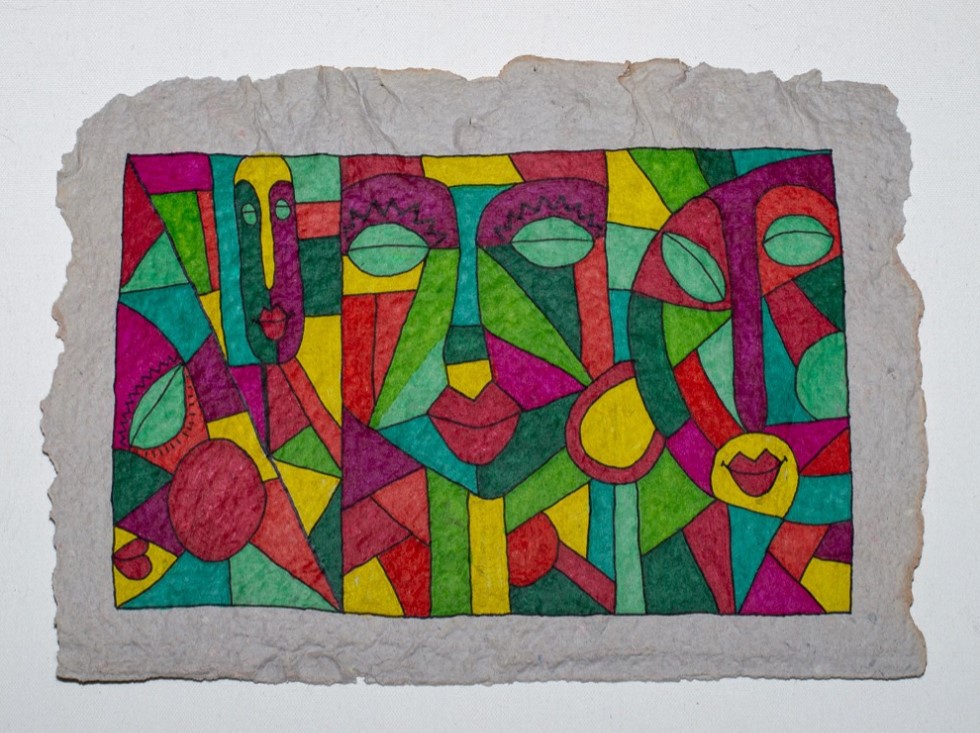
In another, the masks appear to be grey ghoulish faces in a shard-like kaleidoscope, like fragments of stained glass in a gothic church. In yet another, where circles, half-squares, and crescents dominate, we are only able to tell the face of the mask through expressive dashes of half-moon blacks and reds in the provinces of the eyes and mouth.
Ruth Agbolade’s surrealist painting seems to express a world of clear divisions—an acknowledgement of possibilities of the African world-view in the globalised influences of the art world. The fragmented mathematical anatomies she paints are imaginatively tasking.
In a canvas of lighter and heavier greys, she inserts mouths of different sizes, each occupying squares, triangles, circles, diameters, and other shapes. It appears, in short, from these eclectic line arrangements and colour schemes, that this artist is concerned with notions of freedom, freewill, and expression, in a highly patterned world.
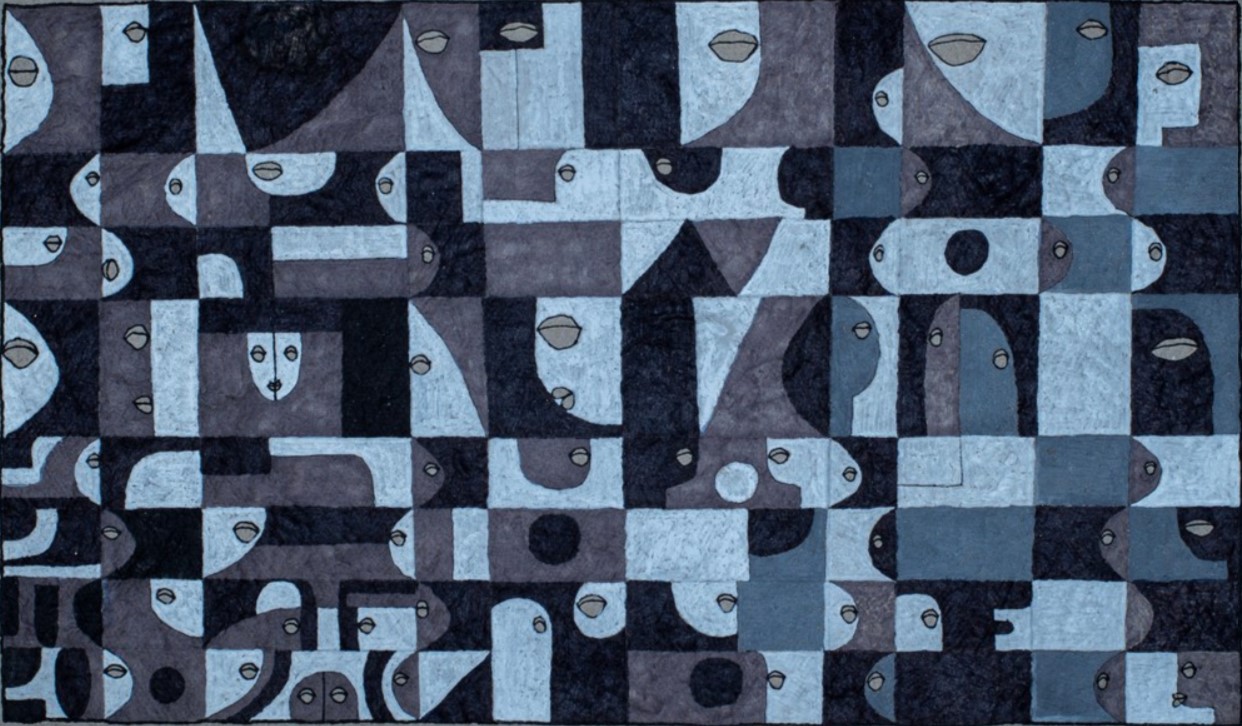
Each surreal image—of masks and other vestigial symbols of indigenous spirituality—have their origins in African culture. In one of her bold canvases, Agbolade seems to draw directly from masquerade traditions such as the Yoruba egungun and the Igbo agbogho mmuo. But here, as is the particularly peculiar style unique to her art, Agbolade breaks down the shapes.
The major phases of the masquerades are interposed through fragmented lines to other broken lines, which delineate lips and skin. The series of paintings that results from this experiments explores a brazen, even lurid feminine essence. (It is there in the deep pinks and purples, and the female torsos, head profiles, and shapes passing for lips, eyes, ears—with such particular details as earrings).
Ruth Agbolade’s aim seems to be to deliberately distort the human face and torso, to break it down and colourfully deconstruct them into new planes of meaning. Here then is the first lesson of Agbolade’s painting: the rallying concerns of what could be better described as her neo-cubism, for its surreal extensions, its deliberately inchoates expressions of spiritual essence of figurative female symbols as well as those of phallic projections.
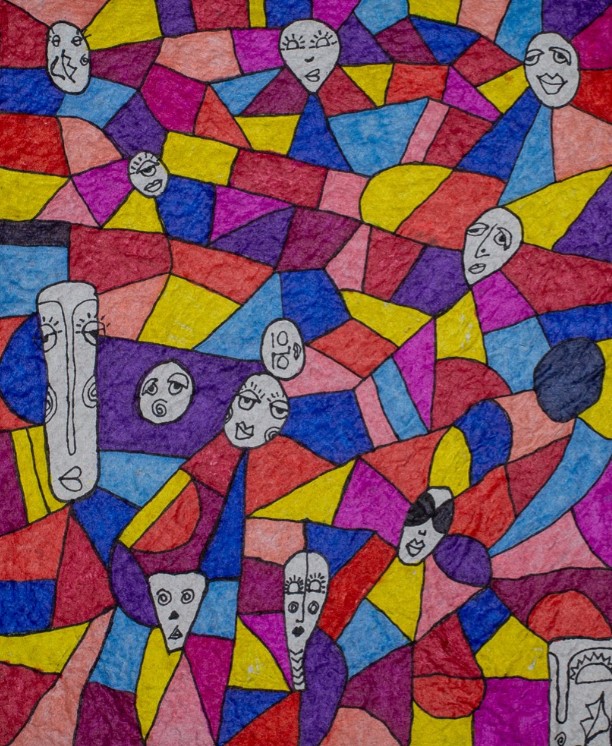
In the fragmented conflations of these paintings, one can also not deny the role that ankara and adire fabric patterns play in Agbolade’s choice of colour combinations and the general appearance of her bold etchings: masks caught amidst yellows, pinks, purples, and different shades of blue. The talent and imagination on display within the frames of these neo-cubist experiments is notable.
II
As a multi-disciplinary artist, Ruth Agbolade has worked across mediums ranging from painting, sculpture to photography and video since she began her professional practice in 2021. Agbolade’s work in installation sculptures departs considerably from her paintings.
Here, plain, non-figurative abstraction takes center stage through a programmatic environmental consciousness, which the artist expresses through an ecology-centered philosophy. A mixed media piece featured at a Sustainability Society programme at the University of Bradford, UK, envisages this approach.
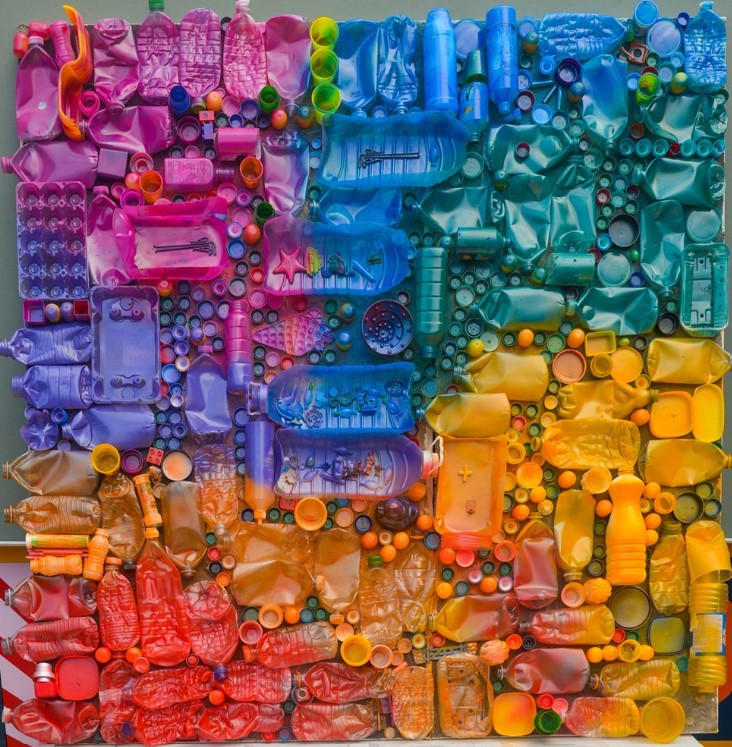
The installation uses disused plastic bottles and containers to create a motherboard-like contraption. The colour combinations and insertions of dozens of plastic bottle caps help to give a sense of an intricate electrical device; in another sense, the contraption seems like an architect’s miniature of a futuristic city. And thus, it raises the difficult questions of the blurry lines between sustainable practices and the sometimes unsustainable means (as with cobalt mining in the DRC) needed to achieve such a sustainable future.
Another important installation employing eco-conscious media, titled Adinkra: Symbols of Wisdom, which was fashioned out of repurposed materials (discarded plastics and paper pulp), spots the artist’s characteristic detailing.

Debuting at the Bradford African Festival of Arts 2024, the piece includes ball-like fragments suspended by means of thin wires from a stony object (obviously in the mold of ancient monoliths) and marked by adinkra symbols and proverbs.
As she explains, each mark holds deep cultural significance, projecting themes of wisdom, resilience, and unity. The powerful message here, beyond cultural heritage and storytelling, is the transformation of waste materials into an object of cultural preservation and renewal.
Other similar sculptures in Agbolade’s oeuvre, including “Fragmented Echoes”, “Eternal Loop”, and “Bound Loop”, repurposes and refashions disused ephemeral materials such as cartons, cardboards, and waste papers to ask thought-provoking questions about consumerism, creation and recreation, and conservation.
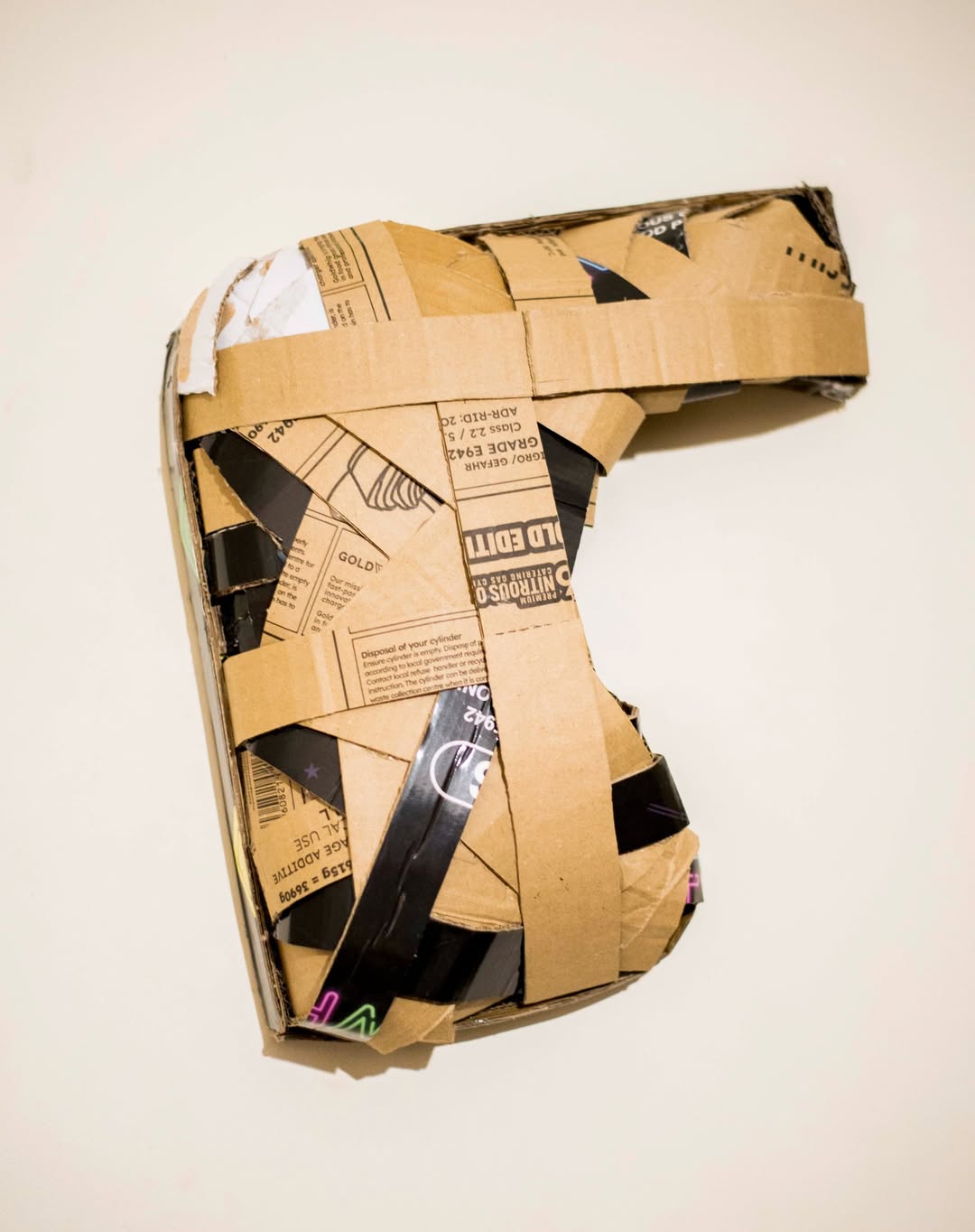
Ruth Agbolade’s rather versatile sculptural work also extends even into formally complex craft arenas, such as her classical marble carving of two knotted clothes, which, with its intricate Quierolo-like detailing, appears to image two supine figures entwined in bondage.
III
Germinal fragments and patterns, such as what could be found under the microbial lenses of a microscope, occupy Agbolade’s earlier work. Here, there are whorls, swirls, isotopic patterns, topographic relief contours, and amoebic etchings.
Many of these patterns and designs seem to be gleaned from African fabrics; one in particular has the nsibidi symbols often found in Akwete cloth. Others, mostly black and white drawings, look like germs or protein formations under a microscope.
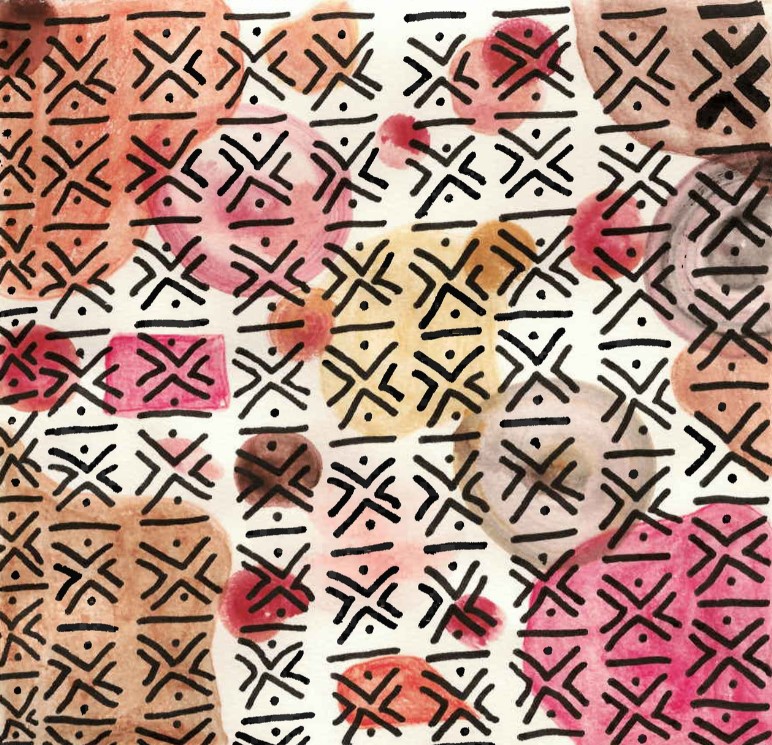
Where colour does appear in these modernist studies, they do in two forms. The first is a series of abstract paintings. A few vague horizontal or vertical brushes of green, yellow, blue, red, brown, and orange. But the brushes are more arbitrary in others, circling or festering in different directions or in particular places.
The second form puts figures and objects into these abstract backgrounds. But even these do not clarify the painterly puzzles, instead, they extend the Pollockian enigma. In one, horizontal squares of colour are sandwiched by script symbols, giving the distinct effect of cutting or attachments. In another, a single yellow line, bordered by frequency fizzes, seems similar to radio waves. This much can be told.
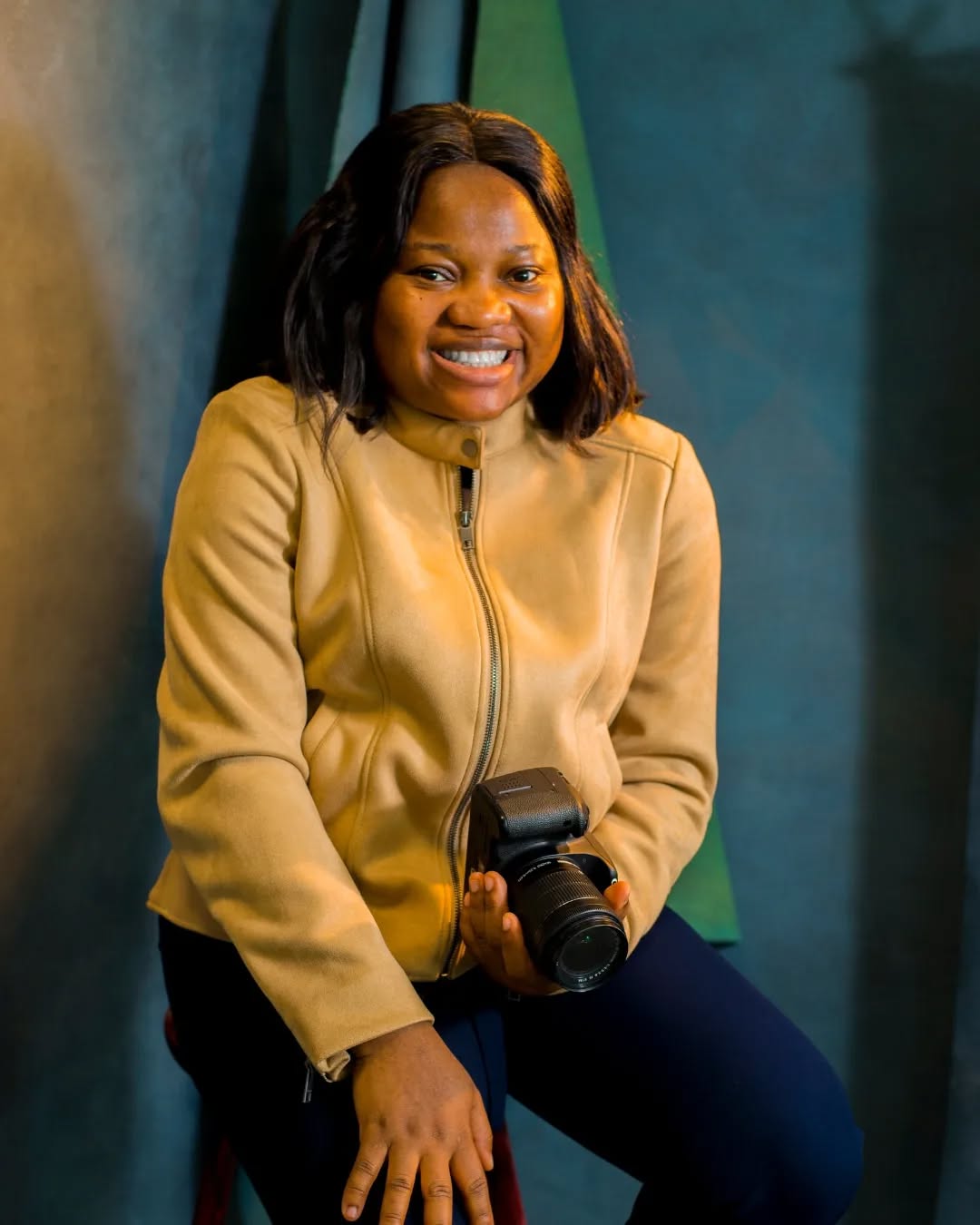
One point of clarity appears in the painting with three figures: a rainbow background with three drawings of female torsos, clad in the same fragmented script-like symbols rooted in African culture and cosmology, faces soporific or smug (depending on viewing angle).
This trinity of the feminine, unevenly heighted, triumphs in earth imagery and the idea of regeneration. In the canvases and positioning of Agbolade’s art, fragmentation and its accompanying surreal expressionism and neo-cubist patterns announce an artist whose varying styles awakens interest in how we view spirituality, culture, science, nature, our anthropomorphic footprints on the earth, and where and how all these converge.
Chimezie Chika is a staff writer at Afrocritik. His short stories and essays have appeared in or forthcoming from, amongst other places, The Weganda Review, The Republic, Terrain.org, Isele Magazine, Lolwe, Fahmidan Journal, Efiko Magazine, Dappled Things, and Channel Magazine. He is the fiction editor of Ngiga Review. His interests range from culture, history, to art, literature, and the environment. You can find him on X @chimeziechika1




